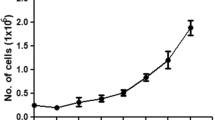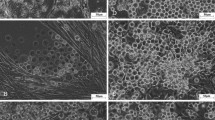Abstract
The fall armyworm, Spodoptera frugiperda (Sf), is a polyphagous lepidopteran herbivore that consumes more than 80 plant species, including many economically important crops, such as corn, soybeans, and sorghum. While already a serious pest in the Americas, it was recently introduced into Africa, India, and China. Because of its high economic costs in the New World and the continent-wide damage potentials in Africa, research to develop advanced pest management technologies is necessary. We are supporting this need by developing novel, next-generation insect cell lines from targeted tissues. Cell lines, such as these, will boost insecticide discovery programs and lead to innovative pest management solutions. Here, we report on the establishment of 16 new cell lines from larval S. frugiperda tissues: nine from the central nervous system, three from the aorta, and four from the testes. We confirmed the identities of the cell lines by DNA amplification fingerprinting polymerase chain reaction, determined their doubling times from growth curves, and described cell types via microscopy. We also developed 16 sublines from three neuronal cell lines.




Similar content being viewed by others
References
Blanco CA, Portilla M, Jurat-Fuentes JL, Sánchez JF, Viteri D, Vega-Aquino P, Terán-Vargas AP, Azuara-Domínguez A, López JD Jr, Arias R, Zhu Y-C, Lugo-Barrera D, Jackson R (2010) Susceptibility of isofamilies of Spodoptera frugiperda (Lepidoptera: Noctuidae) to Cry1Ac and Cry1Fa proteins of Bacillus thuringiensis. Southwest Entomol 35:409–415
Boeckel GR, Ehrlich BE (2018) NCS-1 is a regulator of calcium signaling in health and disease. BBA-Mol Cell Res 1865:1660–1667
Carneiro AA, Gomes EA, Guimarães CT, Fernandes FT, Carneiro NP, Cruz I (2008) Molecular characterization and pathogenicity of isolates of Beauveria spp. to fall armyworm. Pesq Agrop Brasileira 43:513–520
Casmuz A, Juarez ML, Socias MG, Murua G, Prieto S, Medina S, Willink E, Gastaminza G et al (2010) Revisión de los hospederos del gusano cogollero del maíz, Spodoptera frugiperda (Lepidoptera: Noctuidae). Rev Soc Entomol Argent (En línea) Revista de la Sociedad Entomológica Argentina 69:209–231
Clapham DE (2007) Calcium signaling. Cell 131:1047–1058
Claus JD, Gioria VV, Micheloud GA, Visnovsky G (2012) Production of insecticidal baculoviruses in insect cell cultures: potential and limitations. Insecticides-basic and other applications. www.intechopen.com. Accessed 21 June 2018
Djerassi C, Shih-Coleman C, Diekman J (1974) Insect control of the future: operational and policy aspects. Science 186:596–607
Geisler C, Jarvis DL (2016) Rhabdovirus-like endogenous viral elements in the genome of Spodoptera frugiperda insect cells are actively transcribed: implications for adventitious virus detection. Biologicals 44:219–225
Goodman CL, Ringbauer JA Jr, Li Y-F, Lincoln TR, Stanley D (2017) Cell lines derived from the squash bug, Anasa tristis (Coreidae: Hemiptera). In Vitro Cell Dev Biol Anim 53:417–420
Hashimoto Y, Zhang S, Blissard GW (2010) Ao38, a new cell line from eggs of the black witch moth, Ascalapha odorata (Lepidoptera: Noctuidae), is permissive for AcMNPV infection and produces high levels of recombinant proteins. BMC Biotechnol 10:50
Jeger M, Bragard C, Caffier D, Candresse T, Chatzivassiliou E, Dehnen-Schmutz K, Gilioli G, Gregoire J-C, Miret JAJ, Navarro MN, Niere B, Parnell S, Potting R, Rafoss T, Rossi V, Urek G, Van Bruggen A, Van der Werf W, West J, Winter S, Gardi C, Aukhojee M, MacLeod A (2017) Pest categorisation of Spodoptera frugiperda. EFSA Journal 15(7):4927
Jessen KR, Mirsky R (2016) The repair of Schwann cell and its function in regenerating nerves. J Physiol 594:3521–3531
Johnson S (1987) Migration and the life history strategy of the fall armyworm, Spodoptera frugiperda in the Western Hemisphere. Int J Trop Insect Sci 8:543–549
León-García I, Rodríguez-Leyva E, Ortega-Arenas LD, Solís-Aguilar JF (2012) Susceptibilidad de Spodoptera frugiperda (JE Smith)(Lepidoptera: Noctuidae) a insecticidas asociada a césped en Quintana Roo, México. Agrociencia 46:279–287
Longo PA, Kavran JM, Kim MS, Leahy DJ (2014) Single cell cloning of a stable mammalian cell line. Methods Enzymol 536:165–172
McIntosh A, Grasela JJ, Matteri RL (1996) Identification of insect cell lines by DNA amplification fingerprinting (DAF). Insect Mol Biol 5(3):187–195
Meng X-Q, Zheng GL, Zhao CD, Wan FH, Li CY (2017) A cell clone strain from Mythimna separata (Lepidoptera: Noctuidae) highly susceptible to Autographa californica multiple nucleopolyhedrovirus (AcMNPV) and M. separata NPV (MsNPV). In Vitro Cell Dev Biol Anim 53:646–650
Omoto C, Bernardi O, Salmeron E, Sorgatto RJ, Dourado PM, Crivellari A, Carvalho RA, Willse A, Martinelli S, Head GP (2016) Field-evolved resistance to Cry1Ab maize by Spodoptera frugiperda in Brazil. Pest Manag Sci 72:1727–1736
Ren Y, Yang N, Yue Y, Jin H, Tao K, Hou T (2018) Investigation of novel pyrazole carboxamides as new apoptosis inducers on neuronal cells in Helicoverpa zea. Bioorg Med Chem 26:2280–2286
Smagghe G, Goodman CL, Stanley D (2009) Insect cell culture and applications to research and pest management. In Vitro Cell Dev Biol Anim 45:93–105
Thomazoni D, Formentini MA, Alves LFA (2014) Patogenicity of entomopathogenic fungi to Spodoptera frugiperda (Smith)(Lepidoptera: Noctuidae). Arq Inst Biol (Sao Paulo) 81:126–133
Walker T, Jeffries CL, Mansfield KL, Johnson N (2014) Mosquito cell lines: history, isolation, availability and application to assess the threat of arboviral transmission in the United Kingdom. Parasit Vectors 7:382
Zhong G, Cui G, Yi X, Sun R, Zhang J (2016) Insecticide cytotoxicology in China: current status and challenges. Pestic Biochem Physiol 132:3–12
Zuccolo E, Lim D, Kheder DA, Perna A, Catarsi P, Botta L, Rosti V, Riboni L, Sancini G, Tanzi F, D’Angelo E, Guerra G, Moccia F (2017) Acetylcholine induce intracellulr Ca2+ oscillations and nitric oxide release in mouse brain endothelial cells. Cell Calcium 66:33–47
Acknowledgments
Mention of trade names or commercial products in this article is solely for the purpose of providing specific information and does not imply recommendation or endorsement by the U.S. Department of Agriculture. All programs and services of the USDA are offered on a nondiscriminatory basis without regard to race, color, national origin, religion, sex, age, marital status, or handicap. We acknowledge the support of BAYER AG through Cooperative Research Agreement 58-3K95-5-1728.
Author information
Authors and Affiliations
Corresponding author
Additional information
Editor: Tetsuji Okamoto
Rights and permissions
About this article
Cite this article
Reall, T., Kraus, S., Goodman, C.L. et al. Next-generation cell lines established from the fall armyworm, Spodoptera frugiperda (Lepidoptera: Noctuidae). In Vitro Cell.Dev.Biol.-Animal 55, 686–693 (2019). https://doi.org/10.1007/s11626-019-00394-9
Received:
Accepted:
Published:
Issue Date:
DOI: https://doi.org/10.1007/s11626-019-00394-9




